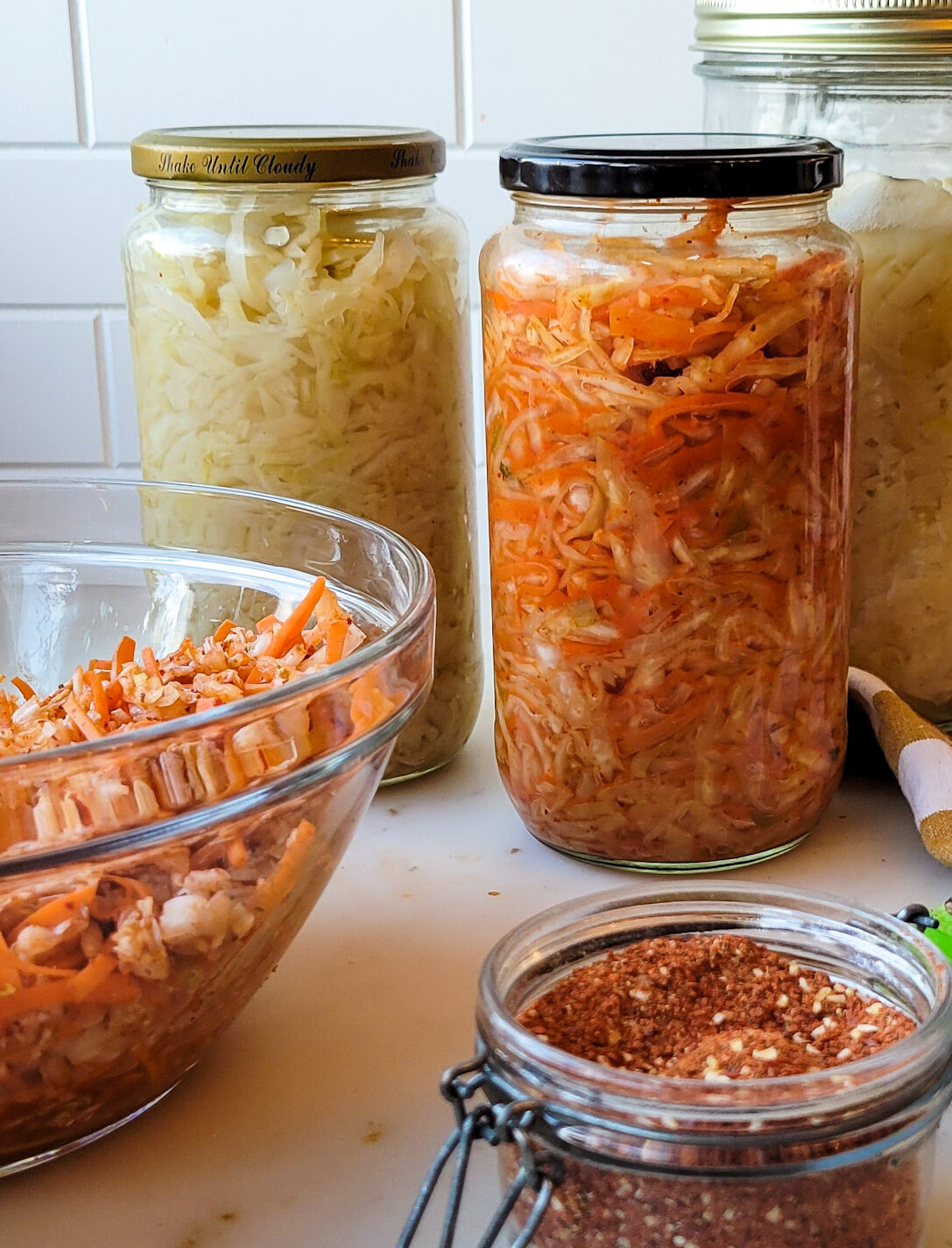
Sauerkraut, Two Ways
Ingredients
Sauerkraut
- 1000 grams white cabbage
- 20 grams kosher salt
Extra Brine, if needed
- 100 grams filtered water
- 2 grams kosher salt
Kimchi Sauerkraut
- 500 grams Napa, green or white cabbage
- 20 grams unrefined sea salt
- 75 grams carrots, julienned
- 30 grams green onions, chopped
- 15 grams kimchi spice blend, see below
- 200 grams filtered water
Kimchi Spice Blend, blend together and store in a sealed container
- 455 grams Gochugaru or Korean chili flakes
- 300 grams dry minced or powdered garlic
- 100 grams ginger powder
- 75 grams kelp granules.
Instructions
Sauerkraut
-
Ensure that your 40 oz jar, or two smaller jars are clean and dry.
-
Remove one or two outer cabbage leaves to be used later. Rinse with cool water and pat dry.
-
Shred the remaining cabbage using a knife, mandoline or food processor. Add 1000 grams to a large bowl. Sprinkle the salt evenly over the cabbage.
-
Using your hands, begin massaging the cabbage firmly. You want to crush the cabbage between your fingers so that the salt can help release the liquid. Pause periodically to let the salt continue doing it's job. Keep working the cabbage for up to two hours, with pauses, until a good amount of liquid is now in the bowl as well. The firmer you crush the cabbage the softer the final sauerkraut.
-
Transfer the cabbage and liquid to the clean fermenting jar. Press down to allow the brine to cover the shredded cabbage. If for some reason you don't have enough brine, prepare the extra brine by combining the water and salt. Pour this over the cabbage till you have up to one inch on top.
-
Use the lid to cut the outer cabbage leaves to an approximate size to fit over the cabbage and brine. Press it down to hold everything under it. Press a weight, stone covered in plastic or even a heavy shot glass on top of the cabbage leaf.
-
Twist the lid on the jar, without closing it all the way. Store on the counter out of the sun. The temperature should be between 65 and 70F.
-
After the second day, twist the lid off for a moment to "burp" the jar. Close again, but not tightly. You will now notice bubbles to start forming at the top around the cabbage leaf. This is good. Keep "burping" the jar once a day till the fermentation process is completed. This should be between 14 and 16 days. It should smell bright and tangy. Taste it, it should taste good! Once you are happy with the flavour, it is ready to transfer to clean jars that will fit in the fridge. Transfer cabbage and brine to those jars and store in the fridge for up to six months.
-
See the blog post for any more details and troubleshooting.
Kimchi Sauerkraut
-
Ensure that your 32 oz or smaller jar(s) weight, and lid(s) are clean and dry.
-
Remove a couple of outer leaves of the cabbage and lightly rinse with cool water. Using a knife, shred the cabbage. Shred or julienne the carrots, and chop the onions.
-
Place a mixing bowl on your kitchen scale and tare/zero the scale. It should read "zero, 0".
-
Add the designated amounts of chopped cabbage. Repeat with zeroing the scale and measuring out the green onions, and then the carrots, and kimchi spices.
-
Remove the full bowl from the scale and set it aside. Place a small, empty bowl on your scale and tare/zero the scale. Weigh out 20 grams of salt.
-
Add the 20 grams of salt to the bowl with the cabbage, and mix with your hands until the cabbage becomes wet. If you are sensitive to pepper, you may want to wear gloves. Firm massaging will result in softer kimchi. If you want it crunchy, be gentle. If using Napa cabbage you will not need to massage for as long. But if using white common cabbage, ensure that you massage it long enough to release liquid and soften well.
-
Place the empty, clean mason jar on the scale, and tare/zero the scale. Make sure your scale is still set to grams, and add 200 grams of filtered water to your mason jar.
-
Pour the 200 grams of water into the bowl with the cabbage and salt. Mix everything well.
-
Starting with the liquid, add the entire contents of the bowl into your clean fermenting jar, and pack everything down using a tamper, wooden spoon, or your hand. Push down till the cabbage is completely submerged in the brine.
-
Over the next 12 hours, the cabbage should release more liquid, in case you don't seem to have enough brine.
-
Use the lid as a guide to cut out a shape in the reserved cabbage leaf. Press this down into the jar over everything. Use a weight, stone wrapped in plastic or a heavy shot glass to push everything down. You want to ensure that the cabbage stays submerged.
-
Secure the solid lid to the jar without twisting it too tight.
-
Ferment for 21-28 days, not forgetting to burp the jar daily during the bubbly phase.
-
Transfer the kimchi and brine to a clean jar(s) and store in the fridge.
-
See the blog post for more details, and troubleshooting.
Recipe Notes
Scale terminology: Taring/zeroing the scale with a container on it, subtracts the weight of the container, allowing you to weigh only what is added to the container. After taring/zeroing the scale, the scale should read 0.0 with the container on it.
Thank you to Cultured Guru for the Kimchi assistance.